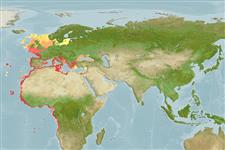Teleostei (teleosts) >
Eupercaria/misc (Various families in series Eupercaria) >
Sparidae (Porgies)
Etymology: Boops: Greek, bous = caw + Greek, ops = appearance, 1854 (Ref. 45335).
More on author: Linnaeus.
Environment: milieu / climate zone / depth range / distribution range
Ecology
Marine; demersal; oceanodromous (Ref. 51243); depth range 0 - 350 m (Ref. 26999), usually 0 - 100 m (Ref. 26999). Subtropical; 63°N - 16°S, 30°W - 42°E (Ref. 54286)
Eastern Atlantic: Norway to Angola, including the Canary Islands, Cape Verde, and the Sao Tome-Principe Islands. Common from Bay of Biscay to Gibraltar (Ref. 4781). Also found in the Mediterranean and the Black Sea.
Length at first maturity / Size / Weight / Age
Maturity: Lm 13.6 range ? - ? cm
Max length : 40.0 cm TL male/unsexed; (Ref. 115876); common length : 20.0 cm TL male/unsexed; (Ref. 3397); max. published weight: 455.00 g (Ref. 115876); max. reported age: 11 years (Ref. 58974)
Found on the shelf or coastal pelagic on various bottoms (sand, mud, rocks and seaweeds). Gregarious, ascending to the surface mainly at night. Omnivorous, feeding mainly on crustaceans, also planktophagous. Hermaphroditic, generally protogynous. Also caught in pelagic trawls (Ref. 9987). Utilized fresh and frozen; consumed pan-fried, broiled and baked (Ref. 9987).
Conflicting descriptions of the reproductive style of this species have been reported, Ref. 34225 describe this species as being a gonochorist (Ref. 28504). Also Ref. 32206, 103751.
Bauchot, M.-L. and J.-C. Hureau, 1990. Sparidae. p. 790-812. In J.C. Quero, J.C. Hureau, C. Karrer, A. Post and L. Saldanha (eds.) Check-list of the fishes of the eastern tropical Atlantic (CLOFETA). JNICT, Lisbon; SEI, Paris; and UNESCO, Paris. Vol. 2. (Ref. 3688)
IUCN Red List Status (Ref. 130435)
Threat to humans
Harmless
Human uses
Fisheries: highly commercial; gamefish: yes; bait: usually
Tools
Special reports
Download XML
Internet sources
Estimates based on models
Preferred temperature (Ref.
123201): 11.7 - 27.7, mean 17.8 °C (based on 912 cells).
Phylogenetic diversity index (Ref.
82804): PD
50 = 0.7500 [Uniqueness, from 0.5 = low to 2.0 = high].
Bayesian length-weight: a=0.01000 (0.00911 - 0.01097), b=3.01 (2.98 - 3.04), in cm total length, based on LWR estimates for this species (Ref.
93245).
Trophic level (Ref.
69278): 2.8 ±0.0 se; based on diet studies.
Generation time: 5.0 (4.1 - 6.4) years. Estimated as median ln(3)/K based on 23
growth studies.
Resilience (Ref.
120179): Medium, minimum population doubling time 1.4 - 4.4 years (K=0.16-0.4; tm=1-2; Fec=395,000).
Prior r = 0.59, 95% CL = 0.39 - 0.88, Based on 3 full stock assessments.
Fishing Vulnerability (Ref.
59153): Moderate to high vulnerability (51 of 100).
Climate Vulnerability (Ref.
125649): Low vulnerability (6 of 100).
Nutrients (Ref.
124155): Calcium = 76 [25, 186] mg/100g; Iron = 4.98 [1.39, 12.01] mg/100g; Protein = 18.5 [17.1, 20.0] %; Omega3 = 0.382 [0.240, 0.638] g/100g; Selenium = 31.9 [14.2, 70.3] μg/100g; VitaminA = 19.7 [5.2, 70.7] μg/100g; Zinc = 3.26 [0.90, 6.11] mg/100g (wet weight); based on
nutrient studies.
